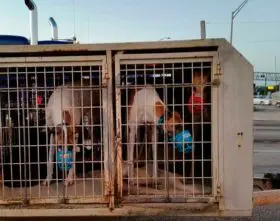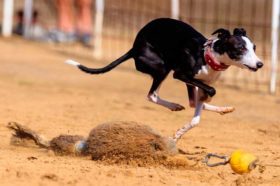Content |
|---|
The greyhounds that are still bred for racing spend most of their time in boxes, pens or fenced enclosures without the love of a family. We can eliminate greyhound racing through education, compassion and action.
Greyhounds are disadvantaged even before birth. Thousands are raised annually, many more than those needed for racing, in an attempt to create the fastest dogs. Often cruel methods are used to get rid of unwanted dogs and dogs that survive in the industry are forced to live in overcrowded conditions. These social creatures are forced to spend most of their time alone, confined in cages for 20-23 hours a day and are denied the opportunity to walk or play. Many dogs are injured while running races and are slaughtered.
What's wrong with greyhound racing?
Greyhound racing is cruel and inhumane and no place for them in the modern era.
When they first emerged at end of the XIX century, supporters did not know that hundreds of thousands of dogs would suffer and die.
Since then, our society has evolved and dog racing are not synchronized with the values ​​of society towards animals.
Today, this type of unnecessary and wasteful suffering is rejected as a form of gambling or entertainment. According to government records now available, common injuries in racing include broken necks and backs, dislocations, torn muscles and paralysis. There have also been electrocutions when dogs come into contact with the lure of high-voltage track. Some dogs die on the track while others are euthanized because of the severity of their injuries or simply because of their value decreased as brokers.
Aren't well-groomed greyhounds used for racing??
Racing greyhounds endure lives of confinement, They are subject to standard practices that are cruel and suffer injuries and even death. Greyhounds used for racing are kept in cages, just large enough so they can stop or turn around, until 23 hours per day. Shredded paper or carpet remnants are used as bed.
Does Greyhound Racing Contribute to Dog Overpopulation??
Yes. From the Platform Not the Chase (NAC) estimate that in Spain there are 'left over' annually about 50.000 greyhounds. The racing industry exacerbates an overproduction of dogs, that simply displaces other homeless animals and diverts resources needed to address other animal welfare challenges.
In the State of Florida (USA), the court will decide whether to vote an amendment to ban racing, declining in the US.
In Argentina, greyhound racing are prohibited. The law prohibits dog racing throughout its territory, any race. Seeks to end a practice that in many cases, according to protectionists, It is accompanied by a cruel treatment to animals. The goal is to sustain economic activity. It does not take into account that the useful life of the animal, raised in extreme conditions, is of 5 years. After that, some try to sell galgueros, often for hunting, where they suffer injuries; otherwise they abandon or kill.
Meanwhile in Portugal, Bill No. 1095/XIII/4th determines the prohibition of the Dog Races best known for greyhound racing. The prohibition extends to the entire national territory, regardless of the race of the dog.
In uruguay, The 20 in December of 2018, The Presidency of the Republic sent to the National Assembly a Draft Law that establishes the prohibition of dog racing throughout the national territory.
In Spain, originally, FEG regulated three modes, Canódromo, Liebre open field and Mechanics, of which currently only the last two exist.
Is greyhound racing inhumane?
Yes. In the United States, thousands of dogs in this industry are kept in enclosures kennels. These enclosures consist of long, narrow buildings with pens for dogs: Dirt tracks where dogs are fenced “removed” and they allowed them to your needs. In these areas, dogs are kept in kennels style warehouse in rows of cages stacked metal.
In the dog tracks of the different states, Greyhounds often suffer serious injuries. Since January 2008 until April 2018, They have documented a total of 15.273 injuries greyhound. The most commonly reported injury was a broken leg. Other injuries included head trauma, Electrocution fractures and back.
Two dog tracks were recorded West Virginia 8.159 greyhound injuries between January 2008 and March 2018, including at the least 398 dogs died or were euthanized.
Are racing greyhounds high?
Data are taken from the United States. In the last decade, has been 438 greyhounds drugged on the ski Florida, including 73 greyhounds high on cocaine. Other positive drugs include novocaine, lidocaine, Industrial solvent DMSO, and opiates like oxycodone and oxymorphone. Greyhound breeders claim that cocaine positives come from environmental contamination, a ridiculous theory that has never been proven in a single case. The state agrees that this scenario is unlikely: “Division finds it much more likely that a prohibited substance is provided to an animal racing purpose for the animal trainer”.
Do greyhounds used in racing receive anabolic steroids?
Yes. Female greyhounds are routinely given an anabolic steroid to prevent lost racing days. In the legislative testimony 2017, Greyhounds Association of Florida estimated the 50 percent of female dogs receiving this drug. This practice is prohibited in greyhound racing in Britain, Australia and New Zealand, due to concerns of integrity and animal welfare. Industry manual Care of the Retired Greyhound Racing and states that the use of anabolic steroids can result in serious side effects harmful, including increased aggression and virilization. According to the Merck Veterinary Manual, “Long-term suppression of zeal is not recommended using androgens, because it is not documented to be safe in breeding dogs… The safety and efficacy of injectable testosterone, as commonly practiced in racing greyhounds, has not been supported by controlled studies are not advised”.
What do racing greyhounds eat??
In the United States, to reduce costs, Greyhounds are fed raw meat of dead animals, dying, sick or disabled (call “meat 4-D”) which it has been deemed unfit for human consumption. Was added carbon denatured meat 4-D to prevent human use. The meat industry uses this inferior quality to reduce costs. According to a manual industry, this meat is used because “It is the most economically feasible for the greyhound industry at this time”. Greyhounds at particular risk of disease pathogens such as salmonella and E. coli, because they are fed raw meat 4-D. Greyhound trainers refuse to cook the meat because they believe it would make the dogs less competitive.
Is disease transmission a concern in greyhound racing??
Yes. The very structure of the industry dog ​​racing allows the spread of contagious diseases. Because hundreds of dogs live in kennels at racetracks storage, when a dog gets sick, many more are exposed. Confinement of dogs in small spaces, the high density of dogs at tracks and the transport of dogs across state lines for racing, all of this allows diseases to spread faster and further than they otherwise would. It's the perfect storm for the transmission of animal disease and stressed by poorly socialized that move in a national circuit to advance the industry profits. When diseases attack, quarantines are imposed at the discretion of the owners of the tracks, which they have strong financial incentives to keep dogs in races.
Does greyhound racing help the economy??
No. Greyhound racing are declining and are not sustainable. Currently, 40 states ban commercial and community-after-community greyhound racing, racing dogs have been replaced by more modern forms of entertainment.
Since 2001, more than 30 Dog tracks have closed across the country and dog racing now accounts for less than one percent of all bets placed each year in the United States.. At present there are only 17 dog tracks in the United States, 11 of which are in Florida until forced to close for 31 in December of 2020.
Why do greyhound trainers treat the dogs they depend on in an inhumane way??
This is an industry driven by profit and those involved are always looking for ways to cut costs and maximize profits. Dogs are only valued if they win money for their owners. If they stop making money, it is economically desirable to rule out dogs and breeding performance under new, perpetuating the endless cycle of cruelty.
Don't people in the industry love their dogs??
People who love dogs treats them as if they were part of the family, in as profit machines. This industry is not built on love, It is built on profits from the exploitation of dogs.
Don't dogs have playtime every day??
While it is true that greyhounds are allowed to leave their cages for short periods of time to relieve themselves, These “shifts” only equates to a few hours per day. Time spent outside their cages does not justify the confinement greyhounds support. This is no way to treat a dog.
Isn't greyhound racing highly regulated?
States with active tracks have minimal regulations regarding dog racing, but these regulations do not prevent thousands of dogs endure lives of confinement, nor prevent hundreds of dogs are seriously injured.
Greyhound racing is largely self-regulated and that is no substitute for public policy that prevents dogs from being cruelly treated for profit. Controls are made at the insistence of humanitarian organizations. Now the humanitarian community is united in its view that this industry languishing must stop the mistreatment of dogs.
En el Southland Greyhound Park Arkansas, between January 2008 and April 2018 were registered 1.148 injuries greyhound, including at the least 35 dogs died or were euthanized.
Greyhound Park in Iowa were recorded 416 greyhound injuries between January 2008 and October 2017, including at the least 29 dogs died or were euthanized.
Is the greyhound industry in decline??
Yes. In the United States, greyhound racing are now illegal in 40 states and be eliminated in Florida for 1 in January of 2021. Among 2001 and 2014, the total amount wagered on greyhound racing across the country decreased by a 70%. This includes betting on live dog racing and simulcast betting, where bettors bet remotely on races taking place elsewhere.





